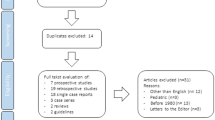Abstract
Purpose
Umbilical hernia is a common complication in patients with cirrhosis. Early studies have reported a high morbidity and mortality associated with hernia repair. The traditional approach has been to non-operatively manage umbilical hernias in patients with cirrhosis. There are emerging data suggesting that an elective repair is a preferable approach. This study examined the outcomes of umbilical hernia repair in patients with advanced liver disease and compared this with a control group of non-cirrhotic patients.
Methods
Prospective data were collected regarding the outcome of umbilical hernia repairs performed between 2004 and 2013 at the Austin Hospital, Melbourne, Australia. Outcomes at 90 days were compared between patients with and without cirrhosis.
Results
79 patients with cirrhosis and 249 controls were analysed. Of the patients with cirrhosis, 9% were classified as Child–Pugh A, 61% were Child–Pugh B and 30% were Child–Pugh C. Emergency repairs for complicated hernias was undertaken in 18% of the cirrhosis population and 10% in controls (P = 0.10). Post-operative complications occurred more commonly in patients with cirrhosis (26%) compared with controls (11%) (P < 0.01). Emergency hernia repairs were associated with a higher complication rate in both patients with cirrhosis (62%) and controls (20%) (P = 0.01). There was no significant difference in the rate of hernia recurrence as assessed by clinical examination between patients with cirrhosis (2.7%) and controls (6.8%) (P = 0.17) nor in 90-day mortality between patients with cirrhosis (n = 1, 1.3%) and the controls (n = 0) (P = 0.43).
Conclusions
Within the limitations of a small study cohort and therefore an underpowered study, elective surgical repair of umbilical hernias in patients with cirrhosis, including decompensated cirrhosis, may not be associated with a significant increase in mortality when compared to a control cohort. Whilst complications are higher in cirrhotic patients, there is no difference in the rate of hernia recurrence. Emergency repairs of umbilical hernias are associated with a high complication rate in cirrhotic patients.
Similar content being viewed by others
References
Belghiti J, Desgrandchamps F, Farges O et al (1990) Herniorrhaphy and concomitant peritoneovenous shunting in cirrhotic patients with umbilical hernia. World J Surg 14(2):242–246
Coelho JCU, Claus CMP, Campos ACL et al (2016) Umbilical hernia in patients with liver cirrhosis: a surgical challenge. World J Gastrointest Surg 8(7):476–482
Ammar S (2010) Management of complicated umbilical hernias in cirrhotic patients using permanent mesh: randomized clinical trial. Hernia 14(1):35–38
Marsman H, Heisterkamp J, Halm J et al (2007) Management in patients with liver cirrhosis and an umbilical hernia. Surgery 142(3):372–375
Choi SB, Hong KD, Lee JS et al (2011) Management of umbilical hernia complicated with liver cirrhosis: an advocate of early and elective herniorrhaphy. Dig Liver Dis 43(12):991–995
Baron HC (1960) Umbilical hernia secondary to cirrhosis of the liver: complications of surgical correction. N Engl J Med 263:824–828
O’Hara ET, Oliai A, Patek AJJ et al (1975) Management of umbilical hernias associated with hepatic cirrhosis and ascites. Ann Surg 181(1):85–87
McKay A, Dixon E, Bathe O et al (2009) Umbilical hernia repair in the presence of cirrhosis and ascites: results of a survey and review of the literature. Hernia 13(5):461–468
Lemmer JH, Strodel WE, Knol JA et al (1983) Management of spontaneous umbilical hernia disruption in the cirrhotic patient. Ann Surg 198(1):30–34
Leonetti JP, Aranha GV, Wilkinson WA et al (1984) Umbilical herniorrhaphy in cirrhotic patients. Arch Surg 119(4):442–445
Pescovitz MD (1984) Umbilical hernia repair in patients with cirrhosis. No evidence for increased incidence of variceal bleeding. Ann Surg 199(3):325–327
Hansen JB, Thulstrup AM, Vilstup H et al (2002) Danish nationwide cohort study of postoperative death in patients with liver cirrhosis undergoing hernia repair. Br J Surg 7:805–806
Carbonell AM, Wolfe LG, DeMaria EJ (2005) Poor outcomes in cirrhosis-associated hernia repair: a nationwide cohort study of 32,033 patients. Hernia 9(4):353–357
Cho HC, Jung HY, Sinn DH et al (2011) Mortality after surgery in patients with liver cirrhosis: comparison of Child–Turcotte–Pugh, MELD and MELDNa score. Eur J Gastroenterol Hepatol 23(1):51–59
de Goede B, Klitsie PJ, Lange JF et al (2012) Morbidity and mortality related to non-hepatic surgery in patients with liver cirrhosis: a systematic review. Best Pract Res Clin Gastroenterol 26(1):47–59
Saleh F, Okrainec A, Cleary SP et al (2015) Management of umbilical hernias in patients with ascites: development of a nomogram to predict mortality. Am J Surg 209(2):302–307
Tsien CD, Rabie R, Wong F (2013) Acute kidney injury in decompensated cirrhosis. Gut 62(1):131–137
Aslani N, Brown CJ (2010) Does mesh offer an advantage over tissue in the open repair of umbilical hernias? A systematic review and meta-analysis. Hernia 14(5):455–462
Author information
Authors and Affiliations
Contributions
SH, GS, AT, MF and PG were involved in conceptualisation of the study. SH, WY and SR performed data collection and analysis. SH and WY performed the statistical analysis. SH, MF and PG drafted the manuscript. SH, WY, SR, GS, AT, MF, PA and PG contributed to the editing and production of the final manuscript.
Corresponding author
Ethics declarations
Conflict of interest
All the authors declare that they have no conflict of interest.
Ethical approval
This retrospective study received ethical approval from the Austin Health's Human Research Ethics Committee.
Human and animal rights
This article does not contain any studies with human participants or animals performed by any of the authors.
Informed consent
For this type of study formal consent is not required.
Rights and permissions
About this article
Cite this article
Hew, S., Yu, W., Robson, S. et al. Safety and effectiveness of umbilical hernia repair in patients with cirrhosis. Hernia 22, 759–765 (2018). https://doi.org/10.1007/s10029-018-1761-9
Received:
Accepted:
Published:
Issue Date:
DOI: https://doi.org/10.1007/s10029-018-1761-9




